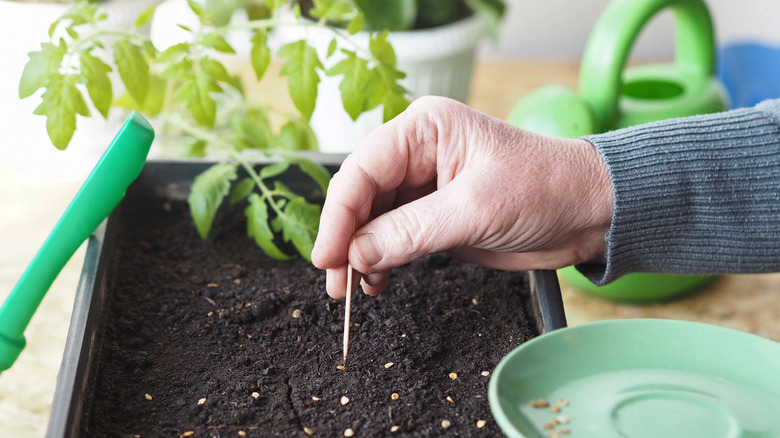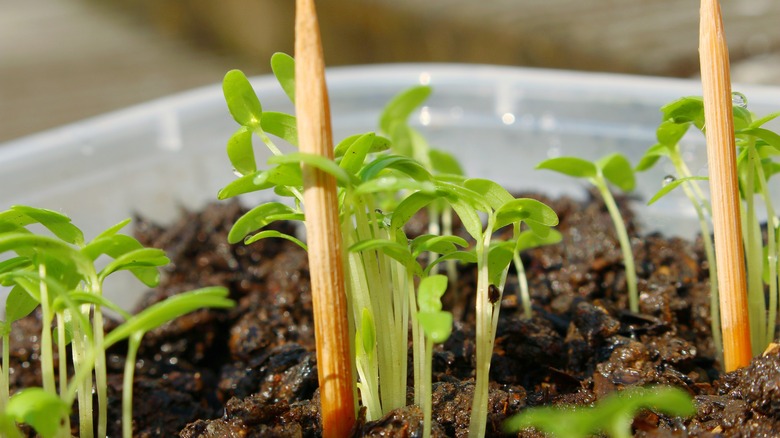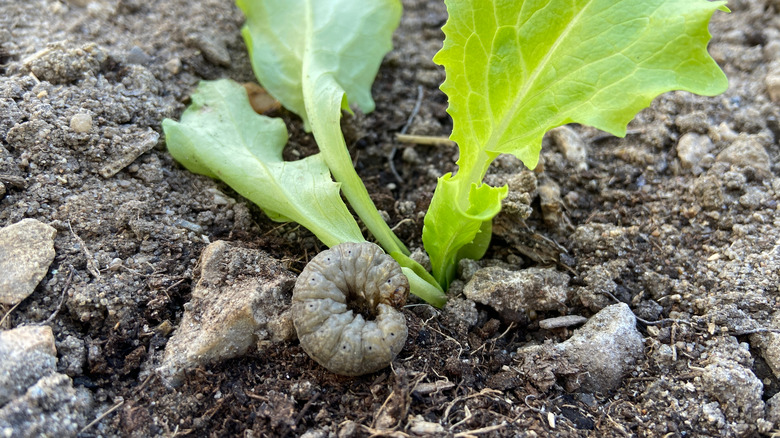Why You Should Place A Toothpick Next To The Seedlings In Your Garden
We may receive a commission on purchases made from links.
Ever spotted toothpicks sticking out of the dirt beside freshly-planted rows of tomato or lettuce seedlings? It looks puzzling to the uninformed, but savvy growers know this nifty — and, bonus, cheap and eco-friendly — idea helps a garden's most vulnerable plants in two vital ways. Place a toothpick into the dirt beside your seedling and pull it out again. If the soil sticks and it looks moist, your seedling is well-hydrated. On the other hand, if chunks of earth fall off and it looks dry, give it a good drink. Incidentally, this might double as the best watering technique to avoid garden pests. There's a tale, tall or otherwise, that says that the same toothpick may also keep hungry herbivores away — cutworms, specifically.
Toothpicks are typically made of a natural, porous material, which differs depending on where you live. In North America, toothpicks are most often made from various softwoods like birch. In China, bamboo is a go-to material, while South Korean toothpick manufacturers use vegetable starch. You can spend less than $2 at Walmart for a pack of 500 bamboo toothpicks, or you can get 5,000 birchwood toothpicks for $15 on Amazon. We also love the plant-colored aesthetic of the green-tipped bamboo picks at Pick On Us, which cost $3.50 for 100. With your toothpicks obtained, it's time to test these ideas for yourself.
Using toothpicks to detect moisture levels
The porosity — or, more accurately, hygroscopicity — of toothpicks is what makes them helpful dew detectors. Through a process called hygroscopy, water in the soil is attracted to the dryness of the toothpick and absorbed into it. The toothpick becomes damp, and the surrounding soil sticks to it, indicating a lot of moisture in the potted plant or garden bed you're curious about. This process won't happen in dry soil, since there's no water for the toothpick to absorb.
As you can probably guess, this works with pretty much any porous object that's hard enough to push into the soil without breaking and thin enough not to cause any damage. Bamboo chopsticks, incense sticks, craft sticks, dried cattail stalks ... even a dry, broken twig from the garden would work. (There are, of course, plastic toothpicks; avoid using those since they're hydrophobic.) Toothpicks are an easy option because they're cheap, don't take up much storage space, and most people already have a few at home.
Jab the pick into the soil around your potted plant, being careful not to nick the stem or any large, exposed roots with the sharp end. After leaving it in for about a minute, pull it back out gently and examine the shaft. Does the toothpick look damp? Are there crumbs of soil sticking to it? If yes, you can skip watering that day and test again tomorrow. With this trick, you'll never overwater your plants again!
Thwarting cutworms with sticks
Now that you may have thousands of toothpicks at your disposal, you're probably wondering whether it's worth exploring the other theory — that planting a toothpick alongside each seedling will keep pesky cutworms from ruining your tomato plants or other seedings. The idea has been around for decades, as evidenced by a passage on the method in a 1989 gardener's advice brochure published by Environment Canada. However, that by no means suggests it's outdated. As recently as 2023, expert sites like the University of Minnesota Extension were recommending the tip. Though the writers of the weekly vegetable update in question admit there's little official research on the method, they suggest gardeners fed up with cutworms, the larvae of the moth Agrotis ipsilon, give it a go.
So, how exactly do you go about impeding pesky cutworms with toothpicks? The pale brown beasties apparently hang out where your plant meets the soil. They curl tightly around the stem when preparing to chow down on your hard-won seedlings. By pushing a toothpick into the ground — a single stick directly against the plant, one a quarter-inch away and parallel to the stem, or one on each side of the plant — you create a protective anti-curling barrier. Older advice says the toothpick fools the cutworm into thinking it has mistaken a seedling for a woody sapling and ignores it. Whatever the case, anything straight and thin like sticks or nails may work for this hack.


